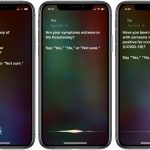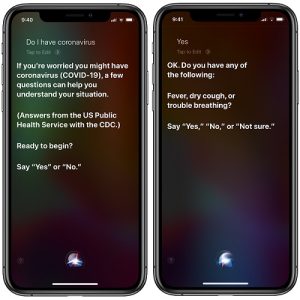Can I Use My iPhone To Determine If I have Coronavirus (COVID-19)?
Siri is now able to help you pinpoint a potential COVID-19 infection! Apple has updated the popular virtual assistant with support for coronavirus symptoms. Basically, your iPhone is now in direct access to the the new CDC questionnaire used by the US Public Health Service. This is the first step of determining potential COVID-19 infested subjects. All that you have to do is ask Siri “Do I have coronavirus?” and play along.Your iPhone, iPad, Mac or any other Apple device that comes with Siri access will instantly prompt you with the above mentioned questionnaire and help you assess your situation. First, you are informed that you will be asked a few yes/no questions that can help you determine if you could be infested or not.To start the survey just answer with “Yes”, when Siri asks if you’re ready to begin!
How To Use Your iPhone To Test Yourself For Coronavirus
1. Wake Siri up by speaking out ‘Hey Siri’ or long-pressing the Sleep/Wake button.
2. Command: “Do I have Coronavirus?”
3. Answer: “Yes”, to start the questionnaire.
4. Questionnaire comes with two main questions:
 Question 1: “Do you have any of the following? Fever, dry cough our trouble breathing?”
Question 1: “Do you have any of the following? Fever, dry cough our trouble breathing?”
Answer Options: “Yes”, “No”, or “Not Sure”.
Question 2: “Have you been in close contact with someone who tested positive for coronavirus (COVID-19)?”
Answer Options: “Yes”, “No”, or “Not Sure”.
Question 3 (only triggered if you answer positive to the first question): “Are your symptoms life threatening?”
Answer Options: “Yes”, “No”, or “Not Sure”.
Siri CDC Questionnaire Recommendations
A. If you answer “No”, to both of the above questions Siri informs you that:
You might be at lower risk for coronavirus (COVID-19) right now, but stay vigilant for symptoms such as fever, dry cough or trouble breathing.
Wash your hands regulary for 20 seconds, and avoid close contact with people outside your household. Remember: people who don’t feel sick can still be contagious.
B. In case your answer to one of the questions is “Not Sure” you will get the following recommendation:
“OK, stay vigilant for symptoms like fever, dry cough or trouble breathing. They may appear up to 14 days after exposure. If that happens, separate yourself from others.
Contact a medical provider if you’re age 65 or over, or have a serious medical condition like lung or heart disease, or diabetes. If you can’t reach a provider, telehealth apps may be able to help.”
C. If you’re positive (“Yes”) at the first question, you will trigger an additional inquiry that asks you if your symptoms are endangering your life. If you confirm that the situation is bad, you get the 911 short dial option. Just speak out “Call 911” and you will be connected to the emergency medical services. If you’re unsure about the severity of your symptoms you can the following recommendation:
“If you experience persistent chest pain or pressure, extreme difficulty breathing, severe shortness of breath, severe constant dizziness or lightheadedness, slurred speech or difficulty waking up, then seek immediate medical attention or call 911.
Otherwise stay home and isolate yourself from others. Contact a medical provider if your condition worsens, you’re age 65 or over, or you have a serious medical condition like lung or heart disease or diabetes.
If you can’t reach a provider telehealth apps may be able to help.”
Hope this helps! Stay at home, stay healthy, keep in touch!

